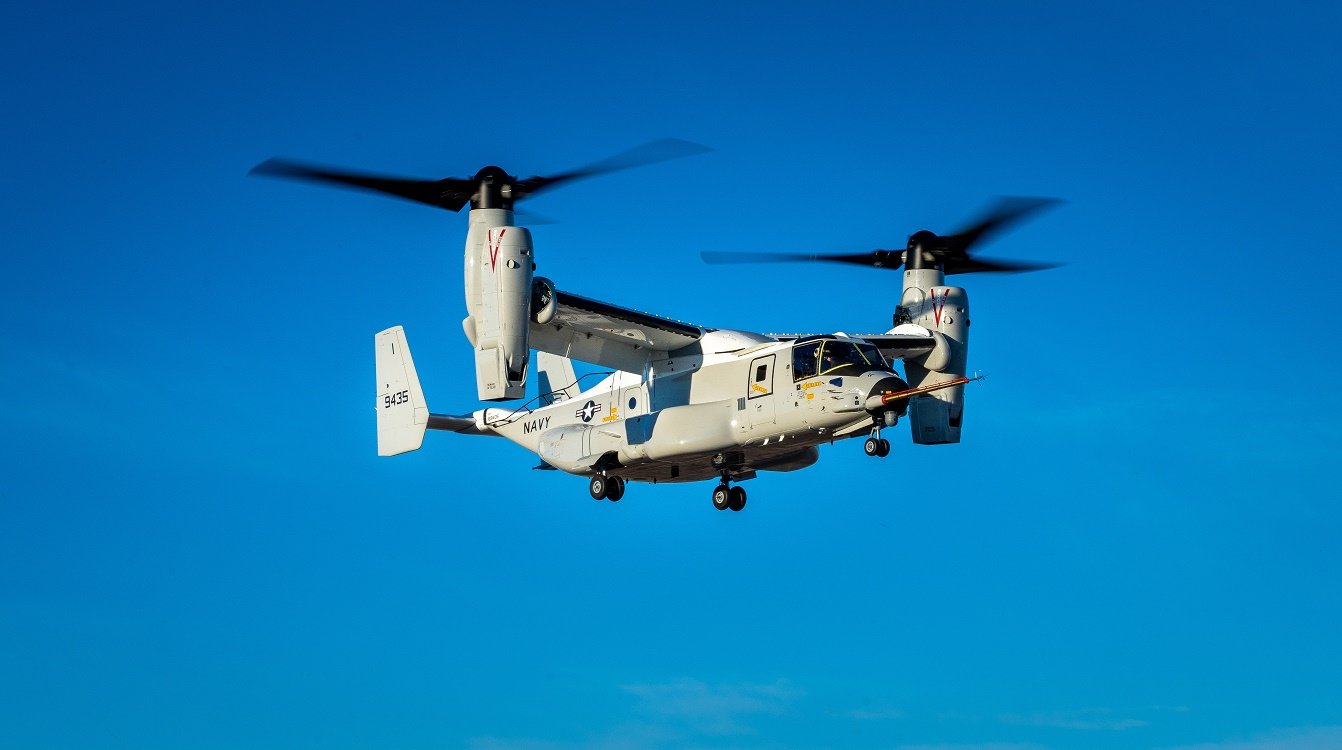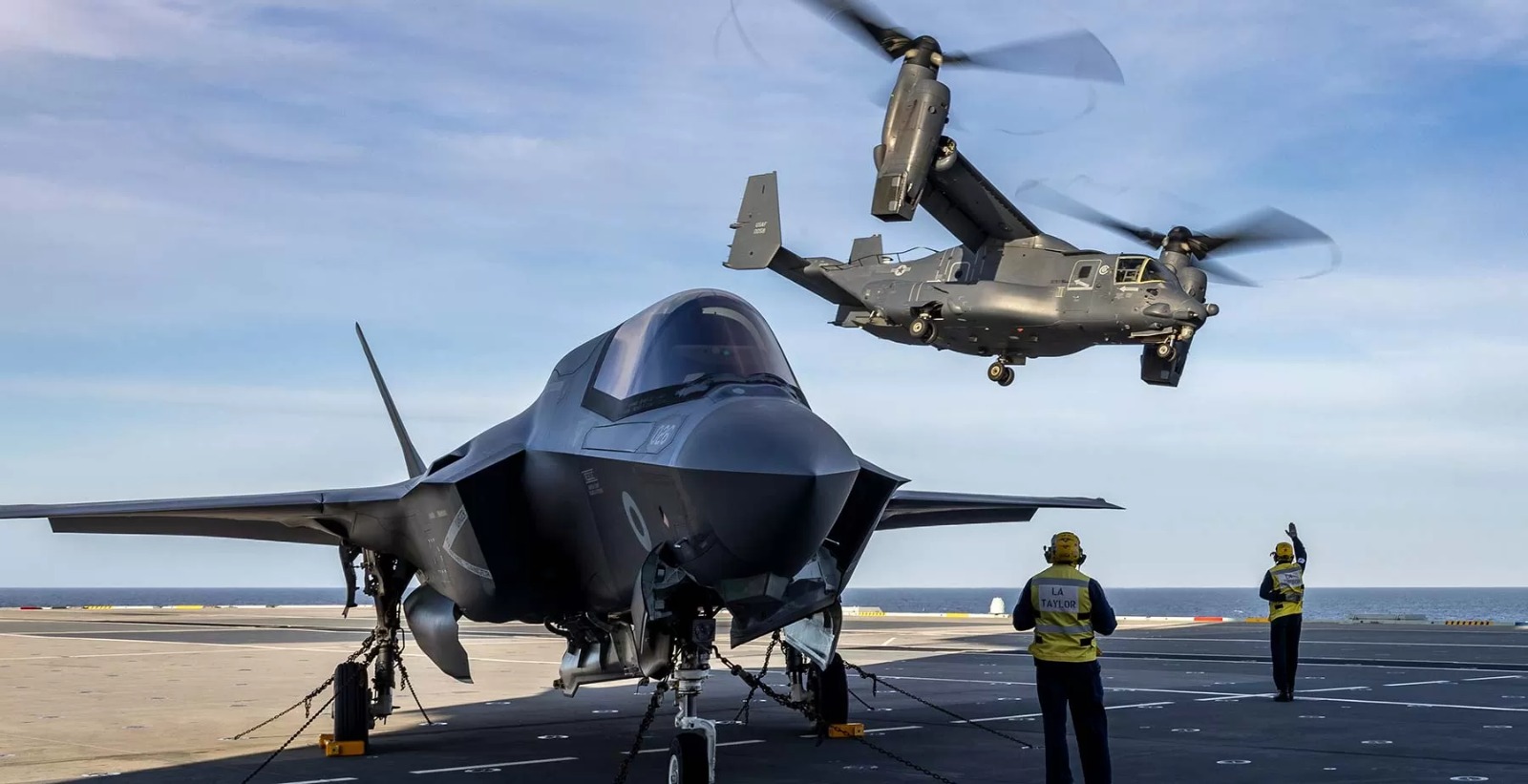A recent Pentagon test has reportedly indicated that the tilt-rotor aircraft CMV-22B Osprey was “Not Operationally Suitable.” It highlights major issues with the U.S. Navy’s (USN) Osprey as the entire V-22 fleet remains grounded following a fatal crash of the U.S. Air Force (USAF) Osprey off the coast of Japan in November 2023.
The USN version was already facing technical issues that limited full exploitation. The grounding forced the USN to rely on C-2A Greyhounds for carrier duties. Till recently the aircraft were being touted as game-changers.
In fact, tilt-rotors were being considered for many civil roles, such as point-to-point transportation and urban air mobility, combining the speed, range, and comfort of a fixed-wing aircraft with the convenience and flexibility of a helicopter.
The missions include VIP and executive transport and medical and rescue services. Flying at almost twice the speed of a conventional helicopter, some could cruise at 25,000 ft. It is thus important to understand and analyze their future.
What Are Tilt Rotors
As the name suggests, the aircraft is designed with rotors that allow lift-off and landing like a helicopter. The rotors are then tilted in flight to give forward propulsion like a propeller aircraft.

The aerofoil of the fixed wings takes over, providing the lift via the forward motion of the entire aircraft. Tilt-rotor thus allows a helicopter’s vertical take-off and landing (VTOL) capability with the speed and range of a conventional fixed-wing aircraft.
A tilt-rotor aircraft differs from a tilt-wing in that only the rotor pivots rather than the entire wing.
Tilt Rotors Evolve
The serious evolution of ideas of constructing vertical take-off and landing (VTOL) aircraft using helicopter-like rotors moved forward in the 1930s. Around 1938, Weserflug in Germany came up with the concept of their P.1003/1, which was in between tilt-rotor and tilt-wings.
Platt and LePage patented the PL-16, the first American tilt-rotor aircraft. The first prototypes to make flight were the single-engine Transcendental Model 1-G and Model 2.
The Model 1-G flew for about a year. Later, the USAF funded the Bell XV-3, which was built in 1953 and flew till 1966, proving the tilt-rotor concept. There were some designers working on tilt-wing. Tilt-rotors were generally found to have better hover efficiency than tilt-wings, but still not as good as helicopters.
In 1972, with funding from NASA and the U.S. Army, Bell Helicopter Textron started developing the XV-15, a twin-engine tilt-rotor research aircraft. In 1981, using experience gained from the XV-3 and XV-15, Bell and Boeing Helicopters began developing the V-22 Osprey, a twin-turbo-shaft military tilt-rotor aircraft for the USAF and the U.S. Marine Corps (USMC).
Later, Bell teamed with Agusta for the Bell/Agusta BA609, which became (AW609) when AgustaWestland took full ownership in 2011. Bell also developed a tilt-rotor unmanned aerial vehicle (UAV), the TR918 Eagle Eye.
Russia has had a few tilt-rotor projects, including the Mil Mi-30, which was meant to replace the Mi-8 and Mi-17 but never progressed much. China unveiled a small tilt-rotor aircraft model at the Helicopter Expo in September 2023. If it succeeds, it will be the smallest tilt-rotor aircraft in the world.
Bell and Boeing also conceptualized a larger Quad TiltRotor (QTR) as part of the U.S. Army’s Joint Heavy Lift (JHL) program. The QTR is a larger, four-rotor version of the V-22 with two tandem wings, a set of fixed wings, and four tilting rotors.
AgustaWestland claims they have free-flown a manned electric tilt-rotor in 2013 called Project Zero, with its rotors inside the wingspan. The Bell Lockheed V-280 Valour made its first flight on December 18, 2017, and, in December 2022, was chosen by the U.S. Army as the winner of the Future Long-Range Assault Aircraft program to replace the Sikorsky UH-60 Black Hawk.
The tilt-rotor’s advantage is significantly greater speed than a helicopter.
In a helicopter, the maximum forward speed is defined by the turn speed of the rotor; at some point, the helicopter will be moving forward at the same speed as the spinning of the backward-moving side of the rotor so that the side of the rotor sees zero or negative airspeed, and begins to stall. This limits modern helicopters to cruise speeds of about 150 knots / 277 km/h.
In a tilt-rotor, because the prop-rotors become perpendicular to the motion in flight, so the tilt-rotor has a relatively high maximum speed. Typically, over 300 knots (560 km/h) have been demonstrated.
More importantly, the benefit of much quicker mission launch response time is the principal virtue sought by the military forces that are using the tilt-rotor. Tilt-rotors are less noisy in forward flight than helicopters. Tilt-rotors also provide substantially greater cruise altitude capability than helicopters.
Albeit, the tilt-rotor propulsion system is much more complex than a conventional helicopter and requires large nacelles and added wings. This also adds to the maintenance complexities.

CMV-22B OspreySuccessful Current Tilt-Rotor Projects
Many tilt-rotors made initial flights, but very few saw certification and operational service. AgustaWestland AW609 is undergoing U.S. Federal Aviation Administration (FAA) certification, and service entry is projected to be sometime in 2024.
The AgustaWestland Project Zero is a hybrid tilt-rotor/Lift fan aircraft. It is a technology demonstrator to investigate all-electric propulsion and other advanced technologies and made its first flight in June 2011.
It is the world’s first electric tilt-rotor aircraft. The Bell Lockheed V-280 Valour is under operational flight testing for the U.S. Army.
Over 400 Bell Boeing V-22 Osprey have been built. The V-22 first flew in 1989. It was the first tilt-rotor for military service. The USMC began crew training for the MV-22B Osprey in 2000 and was inducted in 2007 to initially supplement and later replace the Boeing CH-46 Sea Knights.
The USAF inducted the CV-22B variant in 2009. The USAF Ospreys has seen operations over Iraq, Afghanistan, Libya, and Kuwait. The USN began using the CMV-22B for carrier on-board delivery duties in 2021.
Japan Self-Defence Forces have inducted 14 MV-22s. The CMV-22 B’s first deployment, aboard the aircraft carrier USS Carl Vinson, was hailed as a success for what it brought to the table for transport services. But there have been technical issues.
Other prospective customers have been India, Israel, and Indonesia.
CMV-22B Technical Problems
The CMV-22B has suffered technical problems due to failures of many subsystems, with the ice protection system accounting for 44% of the total operational mission failures as per the Pentagon’s Office of the Director of Operational Test and Evaluation (DOT&E) 2023 annual report released recently.
Also, the lack of cabin pressurization means flying at lower altitudes and need of oxygen for passengers and crew. Flight at lower altitudes means having to face worse weather and reduced range. This becomes more complex when making flights over sea with fewer diversionary landing options.
The USN’s CMV-22B received its Initial Operating Capability (IOC) only in February 2023, where it had only partially met reliability requirements, as per the Pentagon’s testing office.
The ice protection system failures meant 25% of mission aborts. Were these failures also linked to previous groundings, was not clear.
Ospreys have suffered a number of serious accidents since the aircraft first flew in 1989. The aircraft required more than normal maintenance-related inspections.
There have been three fatal Marine MV-22B crashes just since March 2022. The USAF had grounded its CV-22Bs in August 2022 after one of the aircraft made an emergency landing in Norway.
The USAF, USN, and the USMC had again grounded some of their Ospreys in February 2023 over concerns with the aircraft’s hard clutch. And now, the entire fleet has been grounded since December 6, 2023, after the November 29, 2023 crash off the coast of Japan that killed all eight aboard.

U.S. Air Force CV-22 Osprey, based at RAF Mildenhall, conducts Deck Landing Training (DLT), practicing take-offs and landings to maintain this competency. (September 21). British NavyIndian Interest in V-22 Osprey
In 2015, the Indian Aviation Research Centre (ARC) reportedly showed interest in acquiring four V-22s for personnel evacuation in hostile conditions, logistic supplies, and deployment of the Special Frontier Force in border areas.
The Indian Navy also reportedly studied the V-22 rather than the E-2D for airborne early warning and control to replace the short-range Kamov Ka-31.
India was perhaps also interested in purchasing six attack version V-22s for rapid troop insertion in border areas. No concrete proposals are known to have been mooted.
Way Ahead
With distributed maritime ops, longer ranges, distances between multi-carrier operations, distances from land-based areas, and the ability for the CMV-22B to land on semi-prepared places, it was once considered a game changer.
The ability of the tilt-rotor to use rolling landings and take-offs when flying with large loads was important since the Osprey is tasked to transport particularly bulky items.
The aircraft could have had a great role for the Indian Air Force (IAF) in the Himalayas. Similarly, the Indian Navy could use them as part of the carrier group and in island territories for quick cargo delivery.
Boeing is developing a roll-on/roll-off aerial refueling kit, which would give the V-22 the ability to refuel other aircraft.
Analysis of the tilt-rotor development phases over many decades has indicated complex design and aerodynamics issues. The U.S. armed forces with global commitments needed the aircraft quickly for force protection.
For countries like India, it is best to wait for teething problems to be resolved before even considering such a platform. Also, the IAF and Indian Navy have many other more emergent priority capability-building requirements.
India’s indigenous helicopter program has come of age. India must accelerate the development of Indian Medium Multi-role Helicopter (IMRH). The V-22 Osprey is not an important, urgent choice for India.





